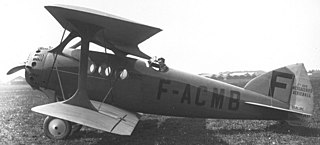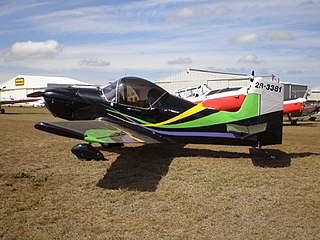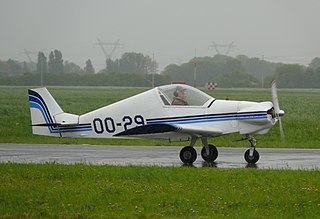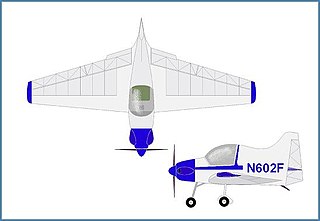Related Research Articles

The Evans VP-2 is a development of the Evans VP-1 Volksplane, both of which were designed in La Jolla, California by aeronautical engineer William Samuel "Bud" Evans. Evans had formerly worked at Convair, Ryan Aircraft and General Dynamics.

The Aerosport Quail is an ultralight aircraft that was designed for home building by Harris Woods. First offered for sale in 1971, by the end of the decade, 375 sets of plans had been sold, with around 26 aircraft under construction and 10 flying.

The Bleriot-SPAD S.33 was a small French airliner developed soon after World War I. The aircraft was a biplane of conventional configuration whose design owed much to the Blériot company's contemporary fighter designs such as the S.20. Four passengers could be accommodated in an enclosed cabin within the monocoque fuselage, and a fifth passenger could ride in the open cockpit beside the pilot. A great success, the S.33 dominated its field throughout the 1920s, initially on CMA's Paris-London route, and later on continental routes serviced by Franco-Roumaine.

The Corby CJ-1 Starlet is a single seat, amateur-built aeroplane designed in the 1960s by Australian aeronautical engineer John Corby.

The Fauvel AV.36 was a single-seat tailless glider designed in France in the 1950s by Charles Fauvel. Although the "AV" in AV.36 stands for Aile Volante, it was not a true flying wing: it featured two large fins mounted on stubby tailbooms extending back from the wing's trailing edge, and accommodated the pilot within a stubby fuselage. The aircraft was designed to be quickly disassembled for road transport, with the nose detaching, and the fins able to fold back against the trailing edge of the wing. A refined version with a slightly longer wingspan, the AV.361 was introduced in 1960.

The Brügger MB-1, MB-2 and MB-3 Colibri is a family of small sports aircraft designed in Switzerland in the 1960s and 1970s for amateur construction.

The Croses Pouplume ("lousefeather") was an unusual ultralight aircraft developed in France in the 1960s. It was inspired by Henri Mignet's Pou-du-Ciel design with its distinctive tandem wing layout. Croses set out to develop a similar aircraft, to be powered by a single-cylinder motorcycle engine of around 6 kW (8 hp). Construction was wood with fabric covering. The resulting machine, designated the EC-1 weighed only 108 kg (238 lb) empty, and first flew in about 1960. Like the Pou-du-Ciel, the Pouplume dispensed with traditional ailerons and elevators, and pivoted the entire forward wing to provide pitch control.
The Fauvel AV.44 was a design for an unorthodox light aircraft produced in France in the 1970s. The work of Charles Fauvel, it was based on his pre-war AV.10 and like it, was a tailless monoplane with a reverse-delta planform and side-by-side seating in an enclosed cabin. The AV.44 featured considerably more modern aerodynamics and accommodation for two passengers in place of the AV.10's one. Five examples were under construction in 1977.
The Fauvel AV.45 was an unorthodox motor glider produced in France in the 1960s and 1970s. Like other Charles Fauvel designs, it was a tailless aircraft, in this case inspired by the work that German firms had done on producing motorised versions of his AV.36 design. The prototype of the AV.45 was an extensively modified AV.36 powered by a Nelson H-59 two-stroke engine. AV.45s have been built with a number of other engines, however, including at least one aircraft powered by a small turbojet. Falconar marketed the plans in the 1970s.

The Fauvel AV.22 was an unorthodox glider produced in France in the 1950s, 60s, and 70s. Originally intended to be produced in series, it was later marketed to homebuilders. Like other Charles Fauvel designs, it was a tailless aircraft, and this particular design featured wings with a slight forward sweep.
The Lefebvre MP.205 Busard was a single-seat racing aircraft built in France in 1975 and marketed for homebuilding. Its design was adapted from that of the Lefebvre MP-204 'Busard' racer, that had been conceived to attempt a world airspeed record in the under 500 kg class in 1949. Compared to its predecessor, the Busard was lightened and intended to be powered by a lower-power engine, and simplified for construction by amateurs. Indeed,the prototype was built by the designer with assistance from students at the Albert Camus technical school of Rouen. Like the MP.204 that it was based on, the Busard was a streamlined, low-wing, cantilever monoplane of conventional design with fixed, tricycle undercarriage. Provision was made for the use of either an aero engine, or a Volkswagen automotive engine.
The McCarley Mini-Mac was a single-seat aerobatic sport aircraft designed in the United States in the early 1970s and marketed for home building. It was a conventional, low-wing cantilever monoplane with a cockpit enclosed by a bubble canopy. The undercarriage was of fixed, tricycle type with spats fitted to the prototype, as well as a small skid fitted as a tail bumper. Construction was of metal throughout.

The Pottier P.80 is a single-seat, single-engine sport aircraft developed in France in the late 1970s and marketed for homebuilding. Ultimately based on the P.70 design, it features a redesigned wing and cockpit canopy. The P.80 is a low-wing cantilever monoplane of conventional design with an enclosed cockpit. Construction throughout is of metal. The prototype was constructed and unveiled at the 1977 Paris Air Show.
The Zenair Mono-Z CH 100 is a single-seat, single-engined Canadian light aircraft of the 1970s. It is a smaller version of the Zenair CH 200 with a less powerful engine, which was sold as a homebuilt aircraft by Zenair.

The W.A.R. FW-190 is a half-scale homebuilt replica of a Focke-Wulf Fw 190 fighter. In July 1973, War Aircraft Replicas International of Santa Paula, California began design of an approximately half-scale replica of the Fw 190, the first of a series of replicas of World War II aircraft using similar constructional techniques. The first prototype made its maiden flight on 21 August 1974.
The Air Est JCD 03 Pelican is a French mid-wing, twin tailed, flying wing single-seat motor glider that was designed by Jean-Claude Debreyer and produced by Air Est Services of Marly, Moselle and supplied as a kit for amateur construction or as a complete aircraft.
The Harmon Der Donnerschlag is an American homebuilt aircraft that was designed and produced by Harmon Engineering of Howe, Texas. The aircraft was intended for amateur construction.

The Fauvel AV.60 (AV for aile volante was a flying wing tourism aircraft built in France in the early 1960s. It was a low-wing monoplane of wooden construction, featuring a flying wing layout.
The Fauvel AV.29 was a design for a transport plane by Charles Fauvel in the late 1930s.
The Fauvel AV.7 was a design for a twin-hull seaplane by Charles Fauvel in the early 1930s.
References
- Taylor, Michael J. H. (1989). Jane's Encyclopedia of Aviation. London: Studio Editions. p. 381.
- Jane's All the World's Aircraft 1977-78. London: Jane's Yearbooks. p. 489.
| This article on an aircraft of the 1970s is a stub. You can help Wikipedia by expanding it. |